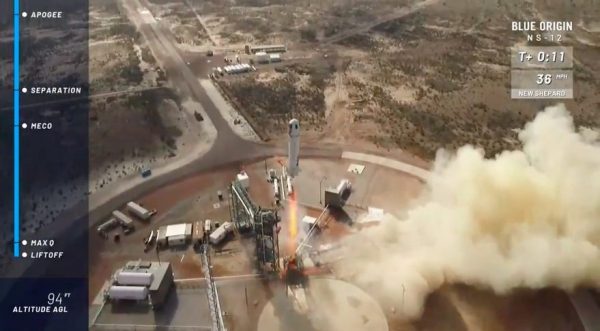New Shepard sets reusability mark on latest suborbital spaceflight – SpaceNews
by —

WASHINGTON — Blue Origin’s New Shepard suborbital vehicle made its first flight in more than seven months Dec. 11 as the company inches closer to flying people to the edge of space.
The NS-12 mission lifted off from Blue Origin’s West Texas test site at 12:53 p.m. Eastern after a day’s delay because of poor weather. The ten-minute flight reached a peak altitude of about 104.5 kilometers, with the vehicle’s propulsion module and crew capsule making separate, successful landings.
The flight was the sixth for this combination of propulsion module and crew capsule, a record for the company. The second New Shepard propulsion module flew five consecutive missions before it was retired for the one being used on this series of flights.
The payloads on New Shepard include eight experiments that are part of NASA’s Flight Opportunities program that provides access to suborbital vehicles. Those experiments range from one from the University of Florida to study changes in gene expression in plants during microgravity to the Orbital Syngas Commodity Augmentation Reactor, or OSCAR, from the Kennedy Space Center to test converting trash into a mixture of gases.
Other payloads were more educational in nature. The vehicle carried two student art projects selected in a competition run by Blue Origin and rock band OK Go. It also hosted thousands of postcards submitted by students through the company’s nonprofit arm, Club for the Future, an effort to encourage students to pursue science and engineering careers. The space-flown postcards will be returned to the students after the flight.
The flight was the first for New Shepard since early May, as the company has moved deliberately towards eventual crewed flights. While company officials said early in the year they expected to fly people by the end of 2019, Bob Smith, chief executive of Blue Origin, backed away from that goal by this fall.
“I’m never going to give up pressure on the team to actually try and go get it done this year,” he said at the TechCrunch Disrupt SF conference Oct. 2. “Is it likely? Probably not, because 2019 is rapidly coming to a close.” He said then the company had at least two more uncrewed test flights before starting crewed flights.
The company reiterated that during this flight. “All in all, today’s flight represents yet another step in verifying New Shepard, the system in total, for human spaceflight,” said Blue Origin’s Ariane Cornell during the company’s webcast of the NS-12 mission. “We’ve got a couple more flights before we get there, but we are going to take our time, step by step.”
Please enable JavaScript to view the comments powered by Disqus.






